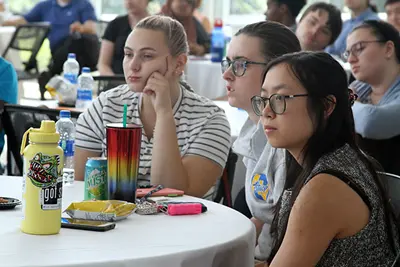Summer Program for First-year Computer Science Majors Sponsored by Red Hat
 Image by Joson Images
Image by Joson Images
Prof. Fred Martin checks on the projects of, from left, incoming freshmen Kate Roseberry, Emilio Santos and Gabriel Vega during the SoarCS summer program held at Alumni Hall on North Campus.
09/04/2019
By Edwin L. Aguirre
Emilio Santos of Methuen has always been interested in computer science.
“I just never had the chance to really dive into it,” he says. But thanks to a new undergraduate initiative at UMass Lowell called SoarCS, incoming freshmen like Santos were able to get a taste of what it’s like to major in computer science before the fall semester begins.
The four-day summer program gave first-year, full-time CS students a chance to live on campus, meet classmates and build skills to help them succeed.
“Aside from learning how to code and discovering software development tools, SoarCS helped students build bonds to form a community of friends and colleagues for support academically and socially throughout the semester and their college careers,” says Prof. Fred Martin, the associate dean for student success at the Kennedy College of Sciences, who heads the program.
The participants were introduced to several current CS students, faculty, staff and alumni. They also found out how careers in computer science could carry them into many fields. The software company Red Hat, which is a subsidiary of IBM, was the program’s primary sponsor.
“Thanks to the generous support from Red Hat, the Kennedy College of Sciences and other sponsors, we were able to offer the program for free,” says Martin.
A Great Experience
According to Martin, a total of 26 freshmen from across Massachusetts registered for this year’s program, which ran Aug. 6-9. Nearly half of the attendees are the first in their families to attend college.
 Image by Joson Images
Image by Joson Images
Parker Tullier, left, and Sakshi Baldawa invent a lightning distance calculator for their project.
Fellow freshman Kate Roseberry of Sterling agrees. A graduate of Montachusett Regional Vocational Technical School, Roseberry says the SoarCS program provided a helpful preview of what’s ahead of her.
“I came in not knowing a whole lot,” she says, “I definitely learned about working with people and meeting the CS community. The program gave me a head start in my studies.”
Like Roseberry, Sakshi Baldawa of Grafton went into the program with very little experience in computer science. “I just wanted to see what it would be like right before I entered college. I felt I’d be overwhelmed if I didn’t know anything about it and just dove right into classes,” Baldawa says.
She adds, “When I first thought about computer science as a major, I thought I’d just be sitting in an office from 9 to 5 as my daily job. But with SoarCS, I realized there were so many other things we could do with computer science. We toured a health lab once, and we saw physical therapy robots in action. That was really interesting, and it’s something I’d like to do and focus on – incorporate health science as a minor and work on robots, prosthetics and medical data to help people.”
Unleashing the Students’ Creativity
SoarCS gave students a chance to take three “dives” into educational computer science technologies. These included micro:bit, a pocket-sized computer that can be used to create or control games, play songs and interact with other devices or connect to the internet via Bluetooth; Cozmo, a miniature AI-powered robot that can be programmed to perform practically any tasks; and MYR, a web-based platform for teaching coding using virtual reality animation.
 Image by Joson Images
Image by Joson Images
For her part, Roseberry used two micro:bits to create music. “I used them in radio function so they could communicate with each other. I was able to generate the beats of the song ‘Here Comes the Sun’ by the Beatles,” she says.
Baldawa worked with Parker Tullier of Stow to invent a lightning distance calculator. “By measuring the time that elapsed between seeing the flash of light and hearing the thunder, the calculator can give you an idea of how far away the storm is,” explains Baldawa.
Arek Wol of Lynn and Nikhila Gubbala of North Chelmsford teamed up to use a Cozmo robot to trace a city skyline with pen and paper, based on the measurements that they had programmed into it. “We learned a lot about coding and other types of programming language like Python,” says Wol.
Other SoarCS activities included a tour of Prof. Holly Yanco’s New England Robotics Validation and Experimentation (NERVE) Center in downtown Lowell, a group meeting with Sciences advising coordinators Meagan Sullivan and Susan O’Neill, and attending Red Hat’s DevConf.US conference on Aug. 17 in Boston.
“For SoarCS students, it was their first time to attend a professional conference, and they all had fun,” says Martin. “They didn’t just attend the meeting; they fully participated in it. In addition to attending talks, the students also went on stage and described their creative projects. Afterward, they went to the exhibitors’ area and met with other conference attendees. Red Hat was a very welcoming and generous partner.”
Based on the success of this year’s program, Martin plans to hold it again next summer. And the students want to play a role, he adds: “A number of them wanted to be involved as mentors.”



